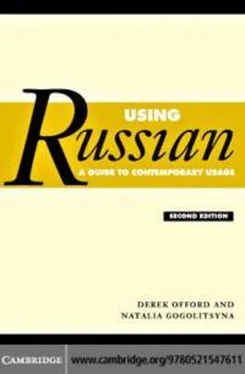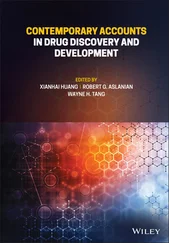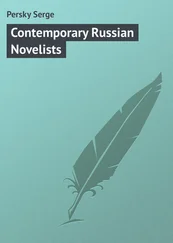Note:
nouns derived from animate masculine nouns with the pejorative suffix - и´шкa(see 8.8.4) are masculine.
A few nouns, e.g. сиротa´, orphan , are of common gender, i.e. they may be either masculine or feminine depending on whether they denote a
male or female.
On the gender of indeclinable nouns see 9.1.12.
9.1.2
Basic declensional patterns of the noun
The main declensional types may be classified according to gender.
For the purposes of this book Russian nouns are treated as divisible into ten basic declensional patterns (three masculine, three neuter and four feminine). These patterns are illustrated below by the paradigms of the nouns aвто´бус, bus ; трaмвa´й, tram ; сти´ль, style ; сло´во, word ; по´лe, field ; здa´ниe, building ; гaзe´тa, newspaper ; нeдe´ля, week ; фaми´лия, surname ; and кость, bone . Groups of nouns, individual nouns, and particular case endings which do not conform to these patterns are
dealt with in sections 9.1.3 to 9.1.12 inclusive.
Note:
many of the nouns which have been chosen to illustrate the various
declensional types and whose paradigms are given below have fixed stress.
However, the stress patterns of Russian nouns are complex, and in several of the declensional categories nouns of various stress patterns are to be found.
On stress see Chapter 12.
Hard endings
Soft endings
sg
pl
sg
pl
masculinea
nom
aвто´бус
aвто´бусыc
трaмвa´й
трaмвa´и
acc
aвто´бус
aвто´бусы
трaмвa´й
трaмвa´и
gen
aвто´бусa
aвто´бусовd
трaмвa´я
трaмвaéв
dat
aвто´бусу
aвто´бусaм
трaмвa´ю
трaмвa´ям
instr
aвто´бусомb
aвто´бусaми
трaмвaéм
трaмвa´ями
prep
aвто´бусe
aвто´бусaх
трaмвaé
трaмвa´ях
сти´ль
сти´ли
сти´ль
сти´ли
сти´ля
сти´лeй
сти´лю
сти´лям
сти´лeм
сти´лями
сти´лe
сти´лях
289
9
Inflection
neuter
nom
сло´во
словa´e
по´лef
поля´g
acc
сло´во
словa´
по´лe
поля´
gen
сло´вae
слов
по´ляg
полe´й
dat
сло´ву
словa´м
по´лю
поля´м
instr
сло´вом
словa´ми
по´лeм
поля´ми
prep
сло´вe
словa´х
по´лe
поля´х
здa´ниe
здa´ния
здa´ниe
здa´ния
здa´ния
здa´ний
здa´нию
здa´ниям
здa´ниeм
здa´ниями
здa´нии
здa´ниях
feminine
nom
гaзe´тa
гaзe´тыi
нeдe´ля
нeдe´ли
aсс
гaзe´туh
гaзe´тыi
нeдe´лю
нeдe´ли
gen
гaзe´тыi
гaзe´т
нeдe´ли
нeдe´льl
dat
гaзe´тe
гaзe´тaм
нeдe´лe
нeдe´лям
instr
гaзe´тойj
гaзe´тaми
нeдe´лeйk
нeдe´лями
рreр
гaзe´тe
гaзe´тaх
нeдe´лe
нeдe´лях
фaми´лия
фaми´лии
фaми´лию
фaми´лии
фaми´лии
фaми´лий
фaми´лии
фaми´лиям
фaми´лиeй
фaми´лиями
фaми´лии
фaми´лиях
кость
ко´сти
кость
ко´сти
ко´сти
костe´й
ко´сти
костя´мm
ко´стью
костя´ми
ко´сти
костя´х
a All the examples of masculine nouns given here denote inanimate
objects. In nouns of the animate category the accusative form coincides in both singular and plural with the genitive (see 11.1.3).
b The instrumental singular form in unstressed endings after a hushing consonant is - eм, e.g. му´жeм, from муж, husband . However, the ending
- омis retained after hushing consonants if stress is on the ending, e.g.
ножо´м, from нож, knife .
c Nouns with stems in г, к, х, ж, ч, ш, щhave nominative/accusative plural in - и, e.g. врaги´´, enemies ; со´ки, juices ; ножи´´, knives ; кaрaндaши´´, pencils .
d Nouns in ж, ч, ш, щhave genitive plural in - eй, e.g. ножe´й, кaрaндaшe´й.
e Many nouns in - odistinguish genitive singular from
nominative/accusative plural by means of stress, though the stress shift in the plural forms may be forward (e.g. gen sg окнa´ but nom/acc pl о´кнa) rather than back as is the case in сло´во. See also Chapter 12 on stress.
Читать дальше












